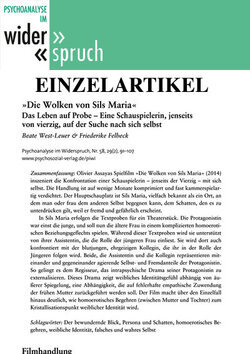17 Seiten, PDF-E-Book
Erschienen: Januar 2018
Bestell-Nr.: 22528
https://doi.org/10.30820/0941-5378-2017-2-91
abonnieren
Beate West-Leuer & Friederike Felbeck
»Die Wolken von Sils Maria« (PDF)
Das Leben auf Probe - Eine Schauspielerin, jenseits von vierzig, auf der Suche nach sich selbst
Sofortdownload
Dies ist ein E-Book. Unsere E-Books sind mit einem personalisierten Wasserzeichen versehen,
jedoch frei von weiteren technischen Schutzmaßnahmen (»DRM«).
Erfahren Sie hier mehr zu den Datei-Formaten.
Olivier Assayas Spielfilm »Die Wolken von Sils Maria« (2014) inszeniert die Konfrontation einer Schauspielerin – jenseits der Vierzig – mit sich selbst. Die Handlung ist auf wenige Monate komprimiert und fast kammerspielartig verdichtet. Der Hauptschauplatz ist Sils Maria, vielfach bekannt als ein Ort, an dem man oder frau dem anderen Selbst begegnen kann, dem Schatten, den es zu unterdrücken gilt, weil er fremd und gefährlich erscheint.
Abstract:
Summary: Olivier Assayas’ film »Clouds of Sils Maria« (2014) depicts a middle-aged actress’ confrontation with herself. The plot is compressed into a few months of time, reminiscent of a chamber theatre formation. The main setting is Sils Maria, well known as the place to come to terms with your other self, i.e. the strange and menacing shadow of your own existence you have so far successfully tried to suppress. It is here that the protagonist is preparing for her role in a stage play, in which she previously portrayed the younger, but now the role of the older woman in a complex homoerotic relationship. During the read-throughs her assistant takes the role of the younger actress and confronts the protagonist with the youth and ambition that her antagonist, a very young and aspiring actress now playing the part of the younger woman, will embody. Together, these two represent conflicting selfand object representations at work in the protagonist. Thus the director succeeds in externalizing the protagonist’s intrapsychic drama, which reveals a feminine identity dependent on object mirroring. This dependency in turn is attributed to a lack of empathetic attention on the part of the primary caregiving mother figure. Derived from this individual case the film demonstrates clearly how homoerotic attraction between mother and daughter does precipitate into a feminine identity.
Abstract:
Summary: Olivier Assayas’ film »Clouds of Sils Maria« (2014) depicts a middle-aged actress’ confrontation with herself. The plot is compressed into a few months of time, reminiscent of a chamber theatre formation. The main setting is Sils Maria, well known as the place to come to terms with your other self, i.e. the strange and menacing shadow of your own existence you have so far successfully tried to suppress. It is here that the protagonist is preparing for her role in a stage play, in which she previously portrayed the younger, but now the role of the older woman in a complex homoerotic relationship. During the read-throughs her assistant takes the role of the younger actress and confronts the protagonist with the youth and ambition that her antagonist, a very young and aspiring actress now playing the part of the younger woman, will embody. Together, these two represent conflicting selfand object representations at work in the protagonist. Thus the director succeeds in externalizing the protagonist’s intrapsychic drama, which reveals a feminine identity dependent on object mirroring. This dependency in turn is attributed to a lack of empathetic attention on the part of the primary caregiving mother figure. Derived from this individual case the film demonstrates clearly how homoerotic attraction between mother and daughter does precipitate into a feminine identity.
Matthias RichterS. 5–7Editorial (PDF)
Rolf VogtS. 9–32Ein psychoanalytischer Blick auf die Flüchtlingskrise und den Brexit als Ausdrucksformen der politischen Utopie »Europa« (PDF)
Eva JaeggiS. 33–43Identität und Resonanz (PDF)
Lutz GoetzmannS. 45–64Über das Unbehagen in der kapitalistischen Kultur (PDF)
Einige Anmerkungen zur Unersättlichkeit des Über-IchsElisabeth RohrS. 65–79Piercings und Tattoos als Abbild adoleszenter Identitätskonflikte (PDF)
Edeltraud Tilch-BauschkeS. 81–89Chronik des Scheiterns einer Utopie - Anmerkungen zu Thomas Vinterbergs Die Kommune (PDF)
Beate West-Leuer & Friederike Felbeck S. 91–107»Die Wolken von Sils Maria« (PDF)
Das Leben auf Probe - Eine Schauspielerin, jenseits von vierzig, auf der Suche nach sich selbstMatthias RichterS. 109–120Erklärungsversuche zum »Behagen am Kulturbruch« (PDF)
Eine ReplikMoritz Senarclens de GrancyS. 121–125Rezension von: Wörler, F. (2015). Das Symbolische, das Imaginäre, das Reale (PDF)
Ludwig JanusS. 125–130Rezension von: Paul Roazen (2014). Sigmund Freud und William C. Bullitt (PDF)
Rolf VogtS. 9–32Ein psychoanalytischer Blick auf die Flüchtlingskrise und den Brexit als Ausdrucksformen der politischen Utopie »Europa« (PDF)
Eva JaeggiS. 33–43Identität und Resonanz (PDF)
Lutz GoetzmannS. 45–64Über das Unbehagen in der kapitalistischen Kultur (PDF)
Einige Anmerkungen zur Unersättlichkeit des Über-IchsElisabeth RohrS. 65–79Piercings und Tattoos als Abbild adoleszenter Identitätskonflikte (PDF)
Edeltraud Tilch-BauschkeS. 81–89Chronik des Scheiterns einer Utopie - Anmerkungen zu Thomas Vinterbergs Die Kommune (PDF)
Beate West-Leuer & Friederike Felbeck S. 91–107»Die Wolken von Sils Maria« (PDF)
Das Leben auf Probe - Eine Schauspielerin, jenseits von vierzig, auf der Suche nach sich selbstMatthias RichterS. 109–120Erklärungsversuche zum »Behagen am Kulturbruch« (PDF)
Eine ReplikMoritz Senarclens de GrancyS. 121–125Rezension von: Wörler, F. (2015). Das Symbolische, das Imaginäre, das Reale (PDF)
Ludwig JanusS. 125–130Rezension von: Paul Roazen (2014). Sigmund Freud und William C. Bullitt (PDF)

